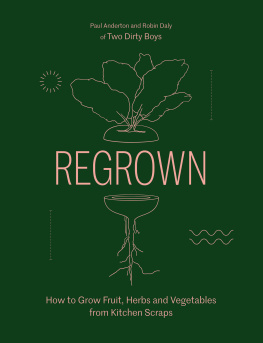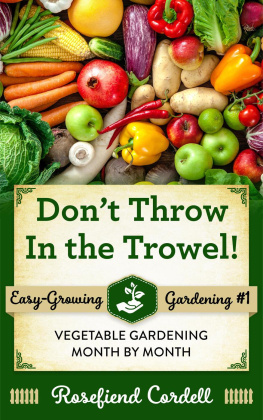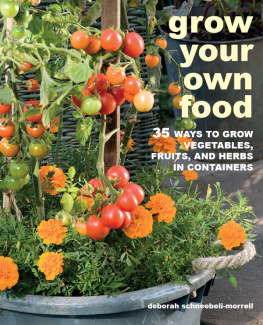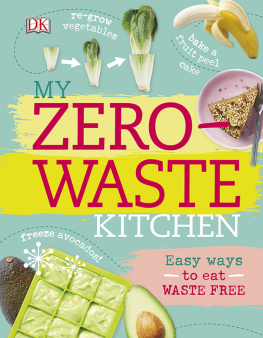dont throw it,
GROW IT!
68 Windowsill Plants from kitchen scraps

Deborah Peterson & MILLICENT SELSAM

I WOULD LIKE TO DEDICATE THIS BOOK POSTHUMOUSLY TO MILLICENT SELSAM, A WONDERFUL FRIEND AND MENTOR.

The mission of Storey Publishing is to serve our customers by publishing practical information that encourages personal independence in harmony with the environment.
Edited by Gwen Steege and Sarah Guare
Art direction and book design by Alethea Morrison
Text production by Liseann Karandisecky
Illustrations by Chip Wass
Indexed by Andrea Chesman
2008 by Deborah Peterson and Millicent Selsam
Original edition published by Random House as The Dont Throw It, Grow It Book of Houseplants by Millicent Selsam and Deborah Peterson, 1977 by Millicent Selsam and Deborah Peterson
All rights reserved. No part of this book may be reproduced without written permission from the publisher, except by a reviewer who may quote brief passages or reproduce illustrations in a review with appropriate credits; nor may any part of this book be reproduced, stored in a retrieval system, or transmitted in any form or by any means electronic, mechanical, photocopying, recording, or other without written permission from the publisher.
The information in this book is true and complete to the best of our knowledge. All recommendations are made without guarantee on the part of the author or Storey Publishing. The author and publisher disclaim any liability in connection with the use of this information. For additional information, please contact Storey Publishing, 210 MASS MoCA Way, North Adams, MA 01247.
Storey books are available for special premium and promotional uses and for customized editions. For further information, please call 1-800-793-9396.
Printed in the United States by Versa Press
10 9 8 7 6 5 4 3 2
Library of Congress Cataloging-in-Publication Data
Peterson, Deborah.
Dont throw it, grow it! : 68 windowsill plants from kitchen scraps.
p. cm.
Includes index.
ISBN 978-1-60342-064-8 (pbk. : alk. paper)
1. Window gardening. 2. House plantsPropagation. 3. Horticultural crops.
I. Selsam, Millicent E. (Millicent Ellis), 19121996. II. Title.
SB419.P415 2008
635dc22
2008005519
Contents
Chapter 1
nitty-gritty growing techniques
Chapter 2
plants from common vegetables
Chapter 3
plants from fruits and nuts
Chapter 4
plants from herbs and spices
Chapter 5
plants from latin america
Chapter 6
plants from asia
Preface
Some thirty years ago, I gave a talk at the Indoor Light Gardening Society of New York, with the title Eat the Fruit and Plant the Seed. After the talk, a diminutive redheaded lady came up to me and said, I want to write a book with you. I thought she was probably daft, but I took her card and checked her out. Milly Selsam was not daft, nor was she an inexperienced writer. She was a well-known author of award-winning childrens science books.
I said yes to Milly, and so began our horticultural adventure. We were fearless New Yorkers scouring the streets of our city in search of ethnic grocery stores and the unknown fruits and vegetables we might find. Our modus operandi was quite simple: we would choose a particular ethnic neighborhood and search the markets there for an unusual fruit or vegetable. From the Latin markets on the West Side and the Bronx to the Indian groceries on Lexington Avenue, the markets in Chinatown and Little Italy, and the Mediterranean markets in Queens, we covered a lot of territory.
We almost always found something new and different. We would each buy two items: one to eat and one to grow. After that, wed have lunch in a local restaurant. Some of our Pit Stop adventures were hysterical and some were a little scary. Milly would pick up each item and carefully scrutinize it for tell-tale roots, soft spots, budding eyes, or firm flesh. Needless to say, this did not thrill the grocers. I suspect we were cursed in many languages.
Years ago, I went on a field trip with one of my children and spied a box of the most unusual tubers I had ever seen: oval, black, and firm as a potato. Following the agreed method of purchase, I bought two for myself and two for Milly. I left the shop to the usual cries of, It wont grow, lady. (I must know that expression in six languages.) Undaunted, I dropped the beautiful tubers off at Millys office. Later that evening Milly called, giggling, and said, You bought preserved goose eggs, you silly. Some of our most marvelous plants started after a visit to an Asian market; they are well worth a little egg on the kitchen floor.
We continued to meet after the book was published, sharing our love of plants, food, and people until Millys death in 1987. When revising information on pits for this book, Millys voice was always in my head.
Much has changed since this book was originally published. Plants that Milly and I considered exotic, such as kiwi, mango, and papaya, are now sold year-round in most supermarkets. The eighties and nineties saw an influx of exotic fruits and vegetables: the malodorous durian from Thailand, the phallic fruit of the cutleaf philodendron, and the sea anemonelookalike rambutan. This was a wonderful time for a pit grower until a family ate imported strawberries from Guatemala and became dreadfully ill. The U.S. governments response was to irradiate all imported fruits and vegetables. Irradiation changes the plants DNA and kills the seeds. We have managed to grow an occasional imported mango or papaya, but it is now best to grow only those fruits and vegetables grown in the lower 48 U.S. states, so that you avoid fruits that have been irradiated and are therefore sterile and wont grow.
When I give a pit talk, I always bring a large bowl of mixed fruits and vegetables. I tell the audience that within the bowl there are annuals, perennials, trees, shrubs, and vines that will all grow! There are wonderful surprises in store for you as you use this book. Grab a friend and make a pit stop! But remember: Always buy two of each one to grow and one to eat.
Chapter 1 Nitty Gritty growing techniques
Join me on a journey both horticultural and gastronomic. This book will show you how to grow plants from the seeds, pits, and roots that you might otherwise discard. I also hope that the book will inspire you to seek out the more unusual fruits and vegetables for planting. Explore local markets, as well as whatever ethnic markets are available to you. I give some direction as to where and when to find some of these unusual plants. If I havent mentioned availability, you can find the herb, fruit, or vegetable year-round in most supermarkets.
Almost every unprocessed fruit or vegetable can be grown into a decorative houseplant. Some are perennials (those that repeat their growth cycle year after year); others are annuals (plants that complete their growth cycle in one season) or biennials (those that complete the cycle in two years). You will be amazed as you discover how these beautiful plants develop.
What Plants Need To Grow
There is no such thing as a green thumb. Plants will grow well if you learn the conditions they require and if you provide the correct light, water, fertilizer, and containers filled with a growing medium, such as water, soil, or peat. The secret to successful gardening is mimicking the natural growing conditions of your plants native habitat.













